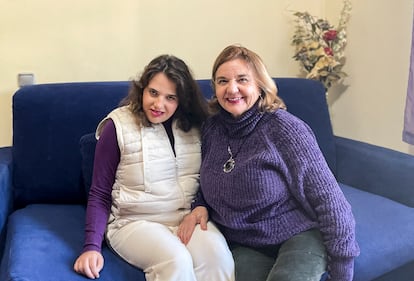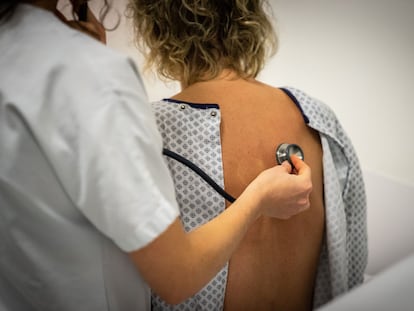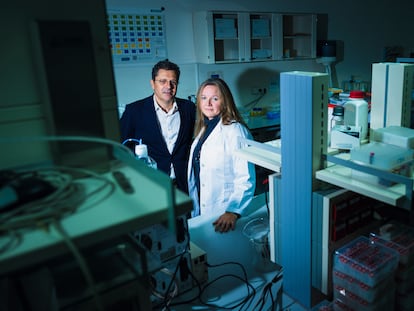Unraveling the mystery of Celia’s inexplicable disease
EU funds research on RASopathies, rare genetic disorders affecting neurodevelopment

It’s all smiles at Encarnación Postigo’s house, because Celia relies on her mother’s upbeat spirit. “You can’t show the stress – it’s all smiles here. We have to be happy at home,” said Postigo. Celia was born with a mutation in her SynGAP1 gene, a very rare genetic disorder that affects neurodevelopment and can cause psychomotor retardation, autism spectrum disorder and epilepsy. Arriving at a diagnosis was challenging, as was coming to terms with it. Like other incurable diseases, there are only a few cases worldwide, and the questions still outnumber the answers. “At the end of the day, all you want is for her not to suffer,” said Postigo, who has turned necessity into a virtue. Together with a group of families affected by genetic disorders, they have launched the EURAS project to study RASopathies, a group of conditions caused by genetic mutations affecting the RAS signaling pathway — a crucial cell communication mechanism. The European Union (EU) now funds and supports this scientific initiative to explore therapies for genetic disorders impacting neurodevelopment, including cardiofaciocutaneous syndrome, Costello syndrome and SynGAP1-related encephalopathy.
It took Celia 17 years to be diagnosed. She was only six months old when her mother began to notice that “something was not right.” Celia’s mother took her see specialists and hospitals until a genetic study provided a diagnosis when Celia was an adolescent. She had a mutation in the SynGAP1 gene, which is located in the brain and plays a crucial role in proper neuronal connections. “When there’s a problem there, hyperexcited neurons can lead to epilepsy and affect neuronal development,” said Juliana Ribeiro, a researcher and SynGAP1 expert at Sant Joan de Déu Hospital in Barcelona.
The effects of a SynGAP1 mutation unfold slowly. “They seem fine when they’re born, but after a few months, a delay in walking and speaking becomes apparent. The symptoms gradually become more noticeable over time,” said Ribeiro. They may experience movement or walking disorders, autism spectrum disorders, behavioral disorders, sleep disorders, or eating disorders (dysphagia). “And more than 90% have intellectual disabilities,” said Ribeiro, who is not involved in the EURAS project.
Celia can only speak a few words and has been dealing with severe epilepsy since the age of 17. “Her impaired motor skills led us to take her out of school. Since turning 18, she has been at home with therapists, battling epilepsy,” said Postigo. She could experience severe seizures at any time, which almost make her lose consciousness. “She’s happy, affectionate and communicates using signs to the best of her abilities. However, she has trouble swallowing and with motor skills, which affect her independence. She needs round-the-clock assistance.”
According to the patient association, there are approximately 1,000 people worldwide with this mutation in the SynGAP1 gene. Of these, 38 are in Spain. While gene therapy is being explored as a potential therapeutic option, currently only symptomatic treatment is available to manage seizures, behavioral disorders and other symptoms.
Despair and urgency
The lack of treatments and the sense of helplessness among families prompted Postigo to envision a research project in pursuit of answers. This initiative aims to benefit her daughter and other children affected by the same disease or other RASopathies. “We were so desperate and had this urgent need for them to be well. Not necessarily cured, but just well,” said Postigo. Patient associations from twelve countries got involved in the project. “The parents established the structure, and we all showed up at every meeting with the scientists,” said Postigo.
The final project proposal, sponsored by families and led by European researchers from Germany, France, Portugal, Spain and Austria, secured over €8 million ($8.62 million) of EU financial support. The four-year project will conduct in-depth research into complex neurodevelopmental diseases. Neurofibromatosis 1 and Noonan syndrome are the most common conditions, presenting a wide range of symptoms such as distinctive facial features, heart defects, skin changes, and varying degrees of neurological and neurocognitive impairments. Rarer RASopathies, like cardiofaciocutaneous syndrome, Costello syndrome, and SynGAP1-related encephalopathy, cause significant neurological impairments including intellectual disability, epilepsy, autism spectrum disorder, behavioral disorder, and sleep disorder. While the physical manifestations of RASopathies can be life-threatening, multidisciplinary symptomatic treatment can help manage them. However, there is currently no specific therapy for neurocognitive symptoms, which imposes a long-lasting burden on the children and their families.
Experts stress the complexity of these diseases, as they affect a crucial signaling pathway in the body. “Our genes create a network of connections, and while cutting a peripheral node may go unnoticed, the disruption of a key element like RAS, which is involved in cell proliferation, has far-reaching effects,” said Francisca Sánchez, a former professor of biochemistry and molecular biology at the University of Malaga (Spain), who provided guidance to parents participating in the project.
Drug trials
The project aims to create a patient registry and search for biomarkers to detect drugs or validate therapies. Multiple research groups are already involved, including Professor Juan Antonio García Ranea from the University of Malaga. “Families work alongside clinical and medical experts to identify and typify symptoms. Proper patient grouping and stratification are crucial in order to develop personalized therapies.” García and his team are participating in the effort to typify symptoms and in the “search for genetic bases in both the pathology and the reversal.” Meanwhile, other researchers explore alternative treatment methods by testing drug effects using cellular models.
The initiative plans to conduct preclinical trials using repurposed drugs to test cognitive motor training in animal models for reversing seizures and autistic behavior. “The most important thing is the patient registry. Without it, clinical studies cannot be done. You have to know how the disease has evolved,” said Marcos Mengual, the father of a nine-year-old boy with a SynGAP1 mutation.
Mengual is one of the key supporters of this project. His family went through a five-year journey with various specialists until their son Lucas was finally diagnosed. “The diagnosis really helped us understand the delay in Lucas’s cognitive development. At five years old, he had the cognitive development of an 11-month-old child. Nowadays, Lucas doesn’t really speak much – just three or four words. But his epilepsy is fairly well controlled,” said Mengual.
With nothing else to cling to, the families are placing their hopes on the research project. However, they are aware of the importance of staying grounded in reality. “The term ‘cure’ is problematic since conditions like autism don’t simply vanish. However, making progress in alleviating symptoms would help the children a great deal,” said Mengual. Postigo is grateful for the dedication of Mengual, Sánchez, García and the patient associations. She just wants her daughter’s life to be the best it can be. García believes in the project’s potential, even though the initiative is ambitious. However, he wants people to know that the project is not just wishful thinking. “If there’s something to find, we have the right tools to analyze all the variables. Discovering the key to alleviating symptoms would be a significant achievement and very valuable for the families.”
Sign up for our weekly newsletter to get more English-language news coverage from EL PAÍS USA Edition
Tu suscripción se está usando en otro dispositivo
¿Quieres añadir otro usuario a tu suscripción?
Si continúas leyendo en este dispositivo, no se podrá leer en el otro.
FlechaTu suscripción se está usando en otro dispositivo y solo puedes acceder a EL PAÍS desde un dispositivo a la vez.
Si quieres compartir tu cuenta, cambia tu suscripción a la modalidad Premium, así podrás añadir otro usuario. Cada uno accederá con su propia cuenta de email, lo que os permitirá personalizar vuestra experiencia en EL PAÍS.
¿Tienes una suscripción de empresa? Accede aquí para contratar más cuentas.
En el caso de no saber quién está usando tu cuenta, te recomendamos cambiar tu contraseña aquí.
Si decides continuar compartiendo tu cuenta, este mensaje se mostrará en tu dispositivo y en el de la otra persona que está usando tu cuenta de forma indefinida, afectando a tu experiencia de lectura. Puedes consultar aquí los términos y condiciones de la suscripción digital.
More information
Últimas noticias
Most viewed
- Sinaloa Cartel war is taking its toll on Los Chapitos
- Oona Chaplin: ‘I told James Cameron that I was living in a treehouse and starting a permaculture project with a friend’
- Reinhard Genzel, Nobel laureate in physics: ‘One-minute videos will never give you the truth’
- Why the price of coffee has skyrocketed: from Brazilian plantations to specialty coffee houses
- Silver prices are going crazy: This is what’s fueling the rally











































